Engagement and the global workplace
Partner Content: Workscape (Steelcase NZ) brings you a Steelcase research study on the links between employee engagement and workplace satisfaction.
Employee engagement is a serious bottom-line issue. It fuels organisations during times of economic growth and, more critically, when market conditions are uncertain and volatile. When workers become disengaged, it costs companies money, slows projects, drains resources and undermines company goals, as well as the efforts of their engaged counterparts. This is why employee engagement is one of the key issues facing leading global organisations today.
Organisations might be able to absorb the effects of a handful of disengaged workers, but many business leaders don’t realize how significant the problem is. This study found that more than one-third of workers in 17 of the world’s most important economies are disengaged and another third are somewhere in the middle, not working against their companies but not driving better business results either. Like other complex problems facing business leaders today, employee engagement has many variables that are difficult to address and slow to change.
Building on decades of primary research about work and the workplace, Steelcase partnered with global research firm Ipsos to understand how the places where people work impact employee engagement. We posed these questions:
Can the office be used as a strategic lever to impact engagement?
What kinds of changes to the work environment will make the biggest impact?
The findings of this study indicate that the work environment can either augment or hinder efforts to boost employee engagement. It also identifies areas of change to the workplace that can have the most positive impact.
KEY FINDING #1
EMPLOYEE ENGAGEMENT POSITIVELY CORRELATES WITH WORKPLACE SATISFACTION
The study found that employee satisfaction with their workplace is directly correlated with higher employee engagement. The most engaged workers are the most satisfied with their work environment. Not surprisingly, those employees who are dissatisfied with their workplace are the least engaged. Engaged workers are the engine that propel an organisation forward. These workers are not only more productive, they also generate more new ideas and fuel innovation. That makes them an especially valuable asset for every organisation, but, unfortunately, they are in limited supply.
The study concludes that, on average, only 13 per cent of global workers are highly engaged and highly satisfied with their work environment. Combined with the 21 per cent who are somewhat engaged and somewhat satisfied, this means only about one-third of the global workforce is fueling the organisational performance businesses need. This varies widely around the world; in some countries as few as five per cent are highly engaged.
What sets engaged employees apart? They are considerably more likely to have positive sentiments towards their organisation and the places where they work—rating most workplace satisfaction and engagement metrics in the 90th percentile. Ninety eight per cent feel their
company is a good fit for them personally and feel a sense of connection with the company culture. These workers report a congenial working atmosphere in which they can socialize with colleagues, share their ideas freely and feel a sense of belonging to the organisation.
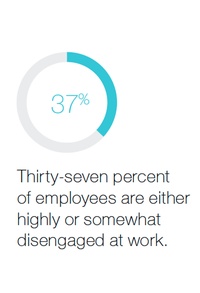
Highly engaged workers are also highly satisfied with various elements of their individual workspace, such as its size, furniture, lighting, ambient noise level and temperature. Their responses suggest they work in places where they also feel optimistic about what they can accomplish at work.
These employees also give their organisation high scores for paying attention to their wellbeing. In fact, 93 per cent say their company takes a genuine interest in their wellbeing and 94 per cent say the company attaches great importance to the health and safety of its employees.
At the opposite end of the spectrum, disengaged workers outnumber their engaged colleagues, with over one-third (37 per cent) scoring highly to somewhat disengaged and dissatisfied with their work environments. Only nine percent of these workers feel that their organisation is genuinely interested in their wellbeing. A mere 10 per cent feel that their employers recognize and value them.
Consistent with their feelings about the organisation, disengaged and dissatisfied employees find little to like about their individual workspace or their workplace overall. They rate most aspects of their spaces in the 20th percentile. Specifically, only 25 per cent are satisfied with the organisation of their workspace and only 27 per cent are satisfied with their furniture. Somewhat brighter spots for these employees are that 39 per cent are satisfied with the lighting in their space and 41 per cent are satisfied with their computer equipment.
About one-third of the global workforce falls somewhere in the middle range: possessing some degree of satisfaction with their workspace and somewhat engaged in the work they do. In general they say they like their working environment and are satisfied with the working atmosphere. Yet, as many business leaders know all too well, moderate engagement and satisfaction rarely breeds optimal productivity or competitive advantage. The untapped potential for improvement among the large group in the middle is tremendous.
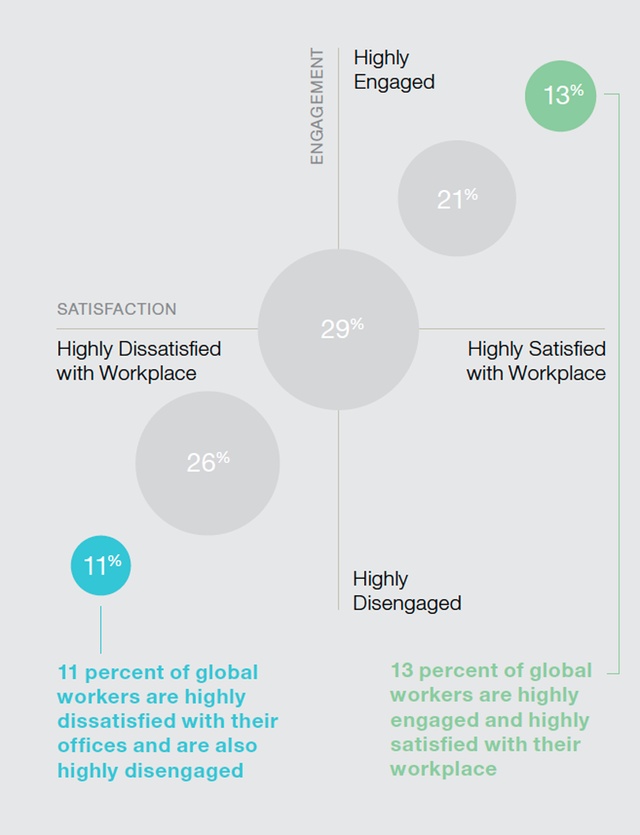
KEY FINDING #2
ENGAGED EMPLOYEES HAVE MORE CONTROL OVER THEIR EXPERIENCES AT WORK
When exploring the differences between engaged and disengaged workers, a consistent theme emerged across diverse data: The more employees feel a sense of control over where and how they work, the more engaged and satisfied they are with their workplace.
The most highly engaged employees have greater flexibility to make choices about where and how they work. They can move around the office easily, change postures and choose where they want to work in the office based on the tasks they need to do.
This flexibility empowers employees to manage their need for privacy throughout the day. Most noteworthy, 88 per cent of highly engaged employees report they can choose where they work in the office depending on the task at hand. This means that if employees need to focus on an important project or get away for a few moments of rejuvenation, they are able to choose places that best support those behaviors, whether it be at their primary individual workspace or at other types of spaces throughout the office.
Eighty-eight per cent of highly engaged workers say they can concentrate easily, and 94 per cent say they can work in teams without being disrupted, both of which reflect important aspects of privacy. More than half can work remotely two or more days per week if they choose, and they tend to have mobile technology to support working in diverse locations, which can also contribute to their ability to seek privacy when needed and feel greater control over their work.
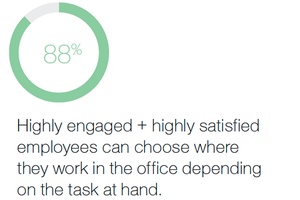
Simply having the option to provide input about one’s office furniture is a stronger indicator of high engagement and satisfaction than working in a private office. In fact, employees who could impact the decision about their furniture and choose from a range of options were more likely to be satisfied with a broad range of attributes about their personal workspace that might not seem related, such as room temperature, ambient noise levels, ventilation and technology equipment.
Having a range of spaces to accommodate different modes of work is key. Organisations that offer a broader range of spaces—for collaboration, socializing, focus, rejuvenation and privacy—tend to have more engaged employees.
The most disengaged employees have the least amount of choice and control over their working environment. The majority, 86 per cent, are unable to choose to work in alternative settings based on the tasks they are doing. Eighty-seven per cent of disengaged workers are frequently interrupted when they work in teams and only 15 per cent say they can concentrate when doing individual work.
These disengaged employees tend to have only the option to work inside the office and often do not have their own workspace. While not having an assigned workspace does not inherently lead to disengagement, this finding suggests the possibility that these nomadic workers work in spaces that have not been designed to best support them and help them feel a part of the organisation. In fact, they do not feel a sense of connection to their organisation and only 35 per cent feel they can have informal, relaxed conversations with their co-workers.
The implications of these findings help inform a number of strategies that organisations can undertake to address engagement. Clearly, providing employees with a greater sense of control over their physical environment and how they work is an opportunity to positively shape behaviors within the organisation.
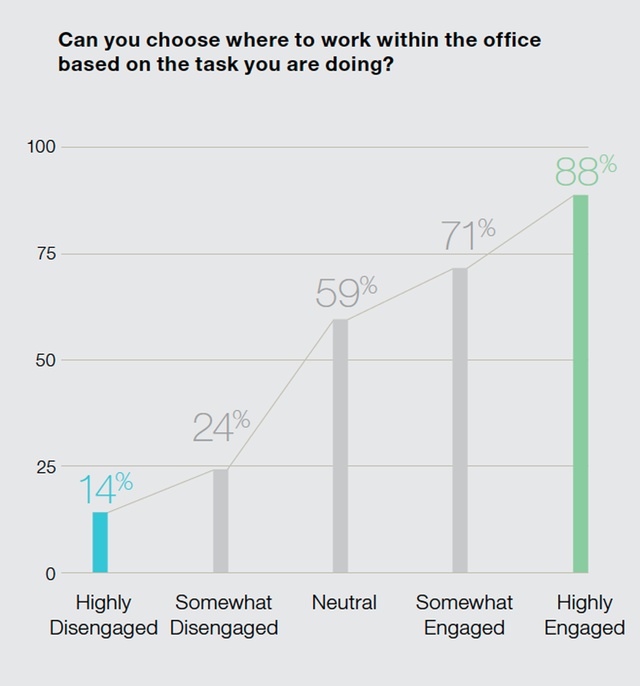
KEY FINDING #3
FIXED TECHNOLOGY EXCEEDS MOBILE 2:1
Access to mobile technology contributes to the employee engagement and satisfaction mix. The most highly engaged workers are more likely to have laptops, mobile phones and tablets than those that are deskbound by landline phones and desktop computers. Access to mobile technology also provides employees more choice and control over their work experience and gives them the freedom to choose where to work within the office based on the task they are doing.
The reality is that most of the world’s workers either have jobs that require them to work at their individual workspace or they are tethered to their desks by technology. While recent reports suggest there are more mobile devices than people on the planet, organisations have leaned toward fixed technology solutions at a ratio of over 2:1. Eighty-six per cent of global workers are provided landline phones and 80 per cent have desktop computers. Only 39 per cent of workers globally have employer-provided laptops and mobile phones while 14 per cent have tablets.
Some of this may be attributed to “bring-your-own-device” programs: 54 per cent of employees globally say they have the option to use their personal computer at work, but the responses were polarized with wide differences between countries where this is more or less common.
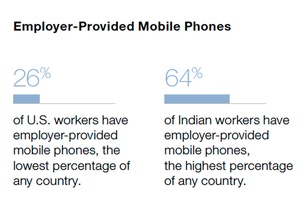
With limited access to mobile technology, it’s not surprising to find the least common workstyle organizations embrace today is one that gives workers choices about where they want to work in the office based on the type of task they’re doing.
Only half of all employees globally have this kind of autonomy and control over their work. The lower level of mobile technology also impacts the opportunity to work outside the office. This study found the majority of employees never work remotely, although this workstyle varies widely and could be attributed to cultural preferences: French employees infrequently work outside the office, where in countries like India, China and South Africa this is far more common.
While the data revealed no correlation between employee engagement and the ability to work outside of the office, it did suggest that a lack of flexible work arrangements might be impacting how people feel about their work experience. Organisations will want to align their workplace and technology strategies to support both resident and nomadic workers and give them the greatest sense of control over their workstyles, appropriate to the type of work they do.

KEY FINDING #4
TRADITIONAL WORKSTYLES PERSIST
Despite the rise of collaborative work globally, more workplaces are configured with entirely private offices than those comprising completely open space configurations (31 per cent vs. 23 per cent). The majority of workplaces (46 per cent) consists of both open and enclosed private spaces.
Office configuration ratios vary significantly by individual country. For example, in the United Kingdom nearly half (49 per cent) report working in open-plan workstations and only 14 per cent in individual offices, while in Germany the reverse is true—more than half (54 per cent) report working in individual offices and only 19 per cent in open plan.
Most employees (60 per cent) are assigned to either an individual or shared private office. Approximately one-third of employees have assigned workspaces in open environments, and a small fraction (8 per cent) are nomadic workers who are not assigned to a specific space and who regularly work in different places in the office. Again, this varies significantly by country; workers in the Netherlands, United Kingdom and Belgium have sizable populations of mobile workers, while in China and Russia this practice is almost nonexistent.

Individual private offices continue to be a function of hierarchy: The higher people are in their organisation, the more likely they are to have their own private office. Because private offices traditionally symbolize status and autonomy—and an implied level of control within many cultures and organisations—it’s predictable that those with private offices are often more satisfied with their work environment overall.
Despite perceptions that work is more collaborative and mobile than ever before, the data show that traditional work environments, and corresponding traditional workstyles, are still more common. Ongoing research will be required to determine the rate of change, if any, happening around the world.
Companies seeking to compete in diverse world markets and become globally integrated are on the forefront of shaping organisational cultures. Employees who see how teammates work in different countries may form new ideas about how they want to work in the future. But there are still significant differences. As organisations seek to become more globally integrated, it will be important to understand these differences to successfully implement changes that can impact employee engagement.
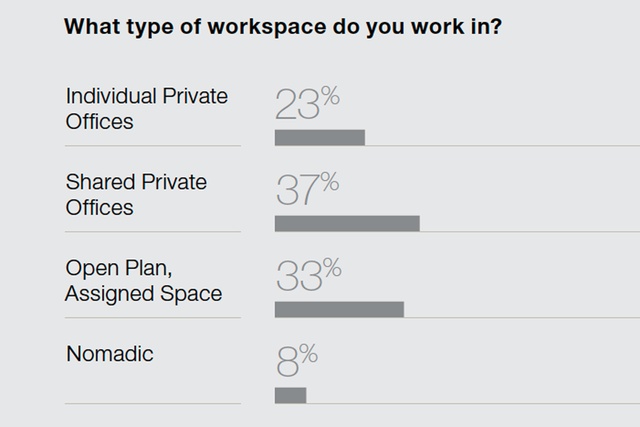
KEY FINDING #5
CULTURAL CONTEXT INFLUENCES ENGAGEMENT LEVELS
The country an employee resides in and its cultural norms and economic factors have an impact on employee perspectives about work and the physical workplace. It can influence how satisfied employees are with the workplace and their overall engagement levels.
This study found the largest concentrations of the most satisfied and most engaged workers are in emerging-economy nations where opportunities are plentiful. Energetic, optimistic attitudes often prevail in these countries and workers are highly satisfied with their environments. At the same time, the data also exposes contrasts and polarization in some countries, which have high levels of both engaged and disengaged workers, with few people in the middle.
Countries that rank low on worker engagement and satisfaction tend to come from established economies with industrial and administrative traditions that often include hierarchical management styles and workplace norms. Workers in these groups often feel stressed and do not feel a sense of belonging to the company and its culture. Satisfaction with their working environment is low.
These findings are important for global organisations that are exploring workplace strategies in different countries and regions. A key insight to this finding is that one solution may not be right for all locations. It is important that organisations consider the cultural context that can influence engagement levels and explore workplace design solutions that best match the needs of people in diverse cultures.

THE RESILIENT WORKPLACE: HOW THE PHYSICAL ENVIRONMENT CAN HELP
Every country has unique characteristics, and no two organisations are alike. Through ongoing research and exploration via behavioral prototypes, Steelcase has uncovered two key design principles that can help organisations create resilient and cost effective workplaces that address the issue of employee engagement.
DESIGN PRINCIPLE #1: DESIGN FOR PHYSICAL, COGNITIVE AND EMOTIONAL WELLBEING
To foster employee engagement the workplace needs to be designed to support employee wellbeing. The study explored broad dimensions of holistic wellbeing that address the physical, cognitive and emotional needs of people.
These specific components of wellbeing are integral to employee satisfaction with their work environment and engagement. When organisations understand this connection between wellbeing and engagement, it can inform and guide design direction for places that can impact engagement.
Designing workplaces to support the holistic wellbeing of people can amplify employee engagement and satisfaction.

DESIGN PRINCIPLE #2: CREATE AN ECOSYSTEM OF SPACES
People at work need to focus, collaborate, rejuvenate, socialize and learn throughout their day. No single type of space can effectively support the diverse needs of individuals and groups. The workplace should be designed as an ecosystem of interconnected zones and settings that are destinations where people have choice and control over where and how they work.
An ecosystem of spaces enables an organisation to be more resilient. It uses real estate more efficiently and cost effectively, making it easier for organisations to experiment with different types of spaces and evolve the workplace over time.
A workplace ecosystem supports employee wellbeing by providing individuals and groups with a range of options within the workplace that consider the following:

THE OPPORTUNITY
The findings in the study underscore that various aspects of wellbeing impact employee engagement. A work environment that meets employees’ most basic physical, cognitive and emotional needs is an essential building block for employee engagement. When those needs aren’t met, it can communicate to people that they aren’t highly valued and make it difficult to create enthusiasm and motivation for the organization’s goals.
Reversing conditions of disengagement takes insight, investment and sustained effort, but the opportunities for organisations that face the problem head-on are tremendous. Throughout the world an office renaissance is underway. Leading organizations are beginning to recognize that their physical workplaces are investments they can leverage to more effectively implement strategies, build brand and support a vibrant culture of engagement. These top-performing companies are ideally positioned to attract and engage the best talent, outperform competitors and thrive.
To learn more about Steelcase workplace research and insights visit 360.steelcase.com.
ArchitectureNow works with a range of partners in the A&D supply sector to source appropriate content for the site. This article has been sponsored by Workscape.










